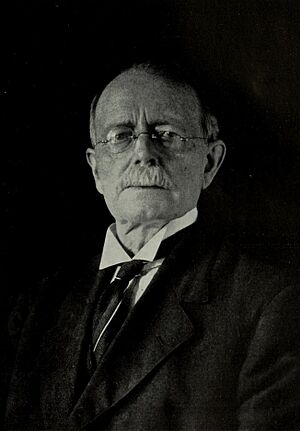John Philip Holland facts for kids
John Philip Holland (born February 24, 1841 – died August 12, 1914) was an amazing Irish engineer. He is famous for creating the first submarine that was officially used by the U.S. Navy. He also designed the first submarine for the Royal Navy, called Holland 1.
Contents
Early Life
Holland was born in a small cottage in Liscannor, Ireland. His father worked for the Royal Coastguard. Holland was one of four boys in his family. His mother spoke Irish, and Holland learned English properly when he went to school.
He later joined the Irish Christian Brothers, a religious group, and became a teacher. He taught in many places across Ireland, including Limerick and Cork City. In 1873, he left the Christian Brothers because he wasn't feeling well. After that, Holland moved to the United States. He first worked for an engineering company, then went back to teaching for six more years in Paterson, New Jersey.
Developing Submarine Designs
Soon after arriving in the United States, Holland broke his leg in Boston. While he was recovering in the hospital, he used his time to make his submarine designs even better. A priest named Isaac Whelan encouraged him.
In 1875, Holland showed his submarine designs to the U.S. Navy. However, they said his ideas wouldn't work. But a group of Irish revolutionaries called the Fenians believed in his work. They gave Holland money to continue his research and development. This allowed him to stop teaching and focus on submarines.
In 1878, he showed off his first working model, the Holland I. Then, in 1881, he launched a submarine called Fenian Ram. But soon after, Holland and the Fenians had a disagreement about money. The Fenian Ram submarine is now kept at the Paterson Museum in New Jersey.
Holland kept making his designs better. He worked on several experimental boats, but the U.S. Navy didn't accept them at first. One of these was the USS Plunger.
Finally, he succeeded with a submarine he built himself, first called Holland VI. It was launched on May 17, 1897. This was a very important submarine! It was the first one that could travel underwater for a long distance. It was also the first to use electric motors for underwater travel and gasoline engines for moving on the surface.
The U.S. Navy bought Holland VI on April 11, 1900, after many tough tests. It was officially put into service on October 12, 1900, and named USS Holland. The Navy then ordered seven more submarines like it. Five were built in New Jersey, and two in California.
The company that grew from these developments was called The Electric Boat Company. It was started on February 7, 1899. This company eventually became a very large defense contractor called General Dynamics.
The design of the USS Holland was also used by other countries. The Royal Navy used it to create their own Holland-class submarine class. Even the first five submarines of the Imperial Japanese Navy used a changed version of Holland's design. These Japanese submarines were a bit longer, about 63 feet. Holland also designed the Holland II and Holland III prototypes. The Royal Navy's 'Holland 1' submarine can be seen at the Submarine Museum in Gosport, England.
Death
John Philip Holland spent 56 of his 73 years working on submarines. He passed away on August 12, 1914, in Newark, New Jersey. He is buried at the Holy Sepulchre Cemetery in Totowa, New Jersey.
Memorial
There is a monument to John Philip Holland in Drogheda, Ireland. It stands at the Scholars Townhouse Hotel, which used to be the Christian Brothers school where Holland taught. The monument was revealed on June 14, 2014, during the Irish Maritime Festival. Representatives from the U.S., British, and Japanese governments attended the ceremony. Also, St. Joseph's Christian Brothers School in Paterson, New Jersey, where Mr. Holland once taught, has been renamed the John P. Holland Charter School.
The John P. Holland Centre in Liscannor, County Clare, is a place dedicated to learning about his life and work.
Submarines Designed by John P. Holland
- Holland I – A small, unarmed submarine. You can see it at the Paterson Museum.
- Holland II (also called Fenian Ram) – This submarine was built for Irish revolutionaries. It is also on display at the Paterson Museum.
- Holland III – A smaller version of the Fenian Ram used for testing how to steer submarines.
- Holland IV (known as the Zalinski Boat) – An experimental submarine paid for by a U.S. Army lieutenant named Edmund Zalinski.
- Holland V (named Plunger) – This was a test submarine to show how useful submarines could be in naval battles. It was launched in 1897 but the U.S. Navy didn't accept it. It was later taken apart in 1917.
- Holland VI – This was the first modern submarine used by the United States Navy. It was launched in 1897 and officially became USS Holland (SS-1) in 1900.
- HMS Holland 1 – This was the first modern submarine used by the Royal Navy.
See also
- Peral Submarine Spanish submarine from 1888
- Gymnote French submarine



